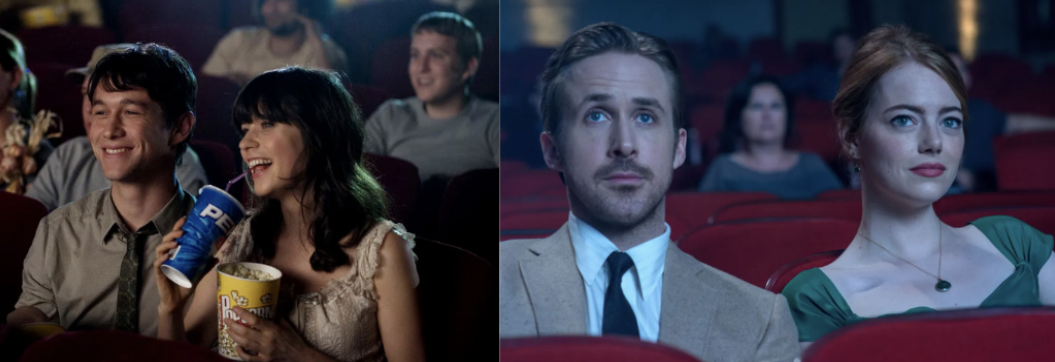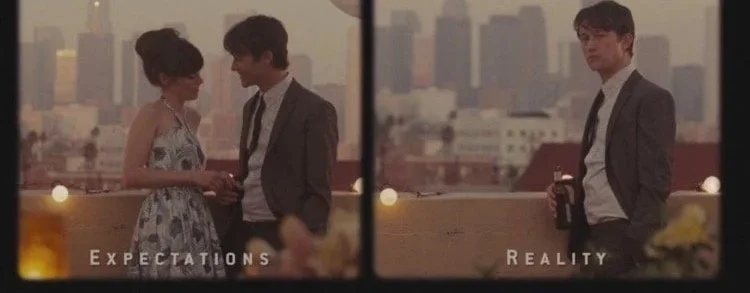To Be Someone’s Summer In The Crowd
Staff Writer Isabel Ng Cardoso ponders the futility of putting someone on a false pedestal in her exploration of how romantic idealisation is utilised or denounced in Damien Chazelle’s La La Land (2016) and Marc Webb’s 500 Days of Summer (2009).
This article contains major spoilers for both films.
“Someone in the crowd could be the one you’re looking for,”– every hopeless romantic knows this iconic lyric from La La Land (2016). “Somewhere In The Crowd” is the song for those who still hold on to the belief that predestined love still exists somewhere somehow. But is it wrong to presume that one might not be looking for a someone, but rather, a something? That perhaps that someone only serves to be a stand-in for what they represent–an ideal of sorts. In innumerous films, their protagonists are often infatuated with some manic pixie dream archetype, someone who serves as the perfect romantic interest, existing solely to make the character happy and to propel their personal growth. There is little to no emotional depth or personal growth of the idealised partner, however, since that is deemed irrelevant to the idealist. This act of romantic idealisation has always been a constant trope in film, and I’m interested in exploring how different directors knowingly play into, and denounce this trope in La La Land and (500) Days of Summer (2009).
The narrative arc of many films, including Damien Chazelle’s La La Land and Marc Webb’s (500) Days of Summer, hinges on the idea that love can be a potential transformative force that resolves internal fragmentation– the “right” person is expected to be a panacea for one’s internal maladies and unfulfilled desires. Just like how people often dub their partner as their missing puzzle piece, many romances portray love interests and partners in the same singular way, thereby reducing love to a form of stagnant completion rather than a complex, evolving relationship between individuals.
In La La Land, the two protagonists, Mia (Emma Stone) and Sebastien (Ryan Gosling), find each other while struggling to chase their dreams. Throughout the first hour, their love blossoms and spearheads the pursuit of their dreams. For Mia, that dream is to become an accomplished actress, and for Sebastien, to establish his own jazz bar. We witness the couple’s emotional support for each other – she makes sure to show up at Sebastien’s shows and he encourages Mia along her acting journey.
Throughout the film, Chazelle’s utilisation of vibrant colours and lively music conjures the illusion of a perfect relationship. This idealisation is represented through the characters’ individual colors: Mia is often dressed in yellow and blue, hues that evoke optimism, creativity, and the limitless hope of a dreamer. By contrast, Sebastien is often associated with red and orange, colours that symbolise passion, intensity, and the grounded urgency of a realist. Through the intimate sunset dance sequence, Chazelle masterfully blends the two colours into shades of purple– a colour historically linked to royalty and power. Much like the merging of colours, the characters also transform and meld into each other– their love becomes a space for mutual influence, where dreamer and realist briefly reconcile their opposing worldviews. In moments like this, we get hooked into the notion of a perfect union– one that transcends differences, where they both come together to become a symbiotic powerhouse.
Moreover, as a musical, it would be impossible not to address the film’s score. Upbeat jazzy tunes inhibit most of the film, further accentuating the idyll of a perfect relationship. Jazz, with its improvisational nature, highlights spontaneity and adaptability, qualities that mirror the couple’s ability to attune to each other, creating harmony even out of difference. Its forward-driving swing also reiterates momentum, the sense of two individuals propelling one another toward their dreams. Furthermore, the musicality of jazz is communication birthed from conflict and compromise –Sebastien echoes this very sentiment in the film. Chazelle’s choice to layer jazz music over the couple’s interactions suggests an optimism that their bond could very possibly overcome any challenges or conflicts thrown their way. Their love is not fragile– it is dynamic. Like jazz, it thrives on tension that is transformed into something beautiful, evident from the sunset sequence as well, thereby framing their relationship as one that, once again, transcends differences.
Two lost souls who found what they were missing in each other, working towards their individual dreams together–how hopeful it would have been if the film had ended here. However, Chazelle violently tramples on this idealistic world, dividing the two instead. The couple eventually splits and pursues their dreams separately, only to briefly reconcile at Seb’s (Sebastien’s eponymous jazz bar) five years later. They acknowledge each other–a fleeting hopefulness–but once again, they go their separate ways.
During this brief reconciliation, a fantastical what-if sequence plays out, an alternate scenario where both of them stayed together, and it is this sequence that solidifies the breakdown of idealism in La La Land. Sprinkled throughout the sequence is the implication that Sebastien’s dream would have been compromised in order for Mia’s to come true. In this alternate reality, Sebastien never ends up running his own jazz bar. Through this, Chazelle the couple’s dreams existed in tension. Either would have been sacrificed for the other. Moreover, there is a blatant emphasis on Mia’s dreams in the sequence, especially illustrated in one of my favourite shots.
The mise-en-scène visualises the structural impossibility of Mia and Sebastien’s relationship. The most striking element– the vertical pole in the off-centre– acts as a physical barrier between the two characters, highlighting the inevitability of their separation. Moreover, the pole is positioned such that it leaves more room for Mia than Sebastien, reinforcing that in this hypothetical alternate world, Sebastien would have had to sacrifice more of himself and his dreams for Mia’s to come true– an imbalance in self-sacrifice and compromise. Ultimately, Chazelle deconstructs this idealistic relationship between the couple using silhouettes and stage-like framing in the mise-en-scène to confront the audience with harsh reality, that the idealisation of romance is but an exaggerated theatricality which, much like a performance, inevitably has to end.
The portrayal of idealism, however, is less subtle in Webb’s (500) Days of Summer, than in La La Land. The main character, Tom (Joseph Gordon-Levitt), is the epitome of a hopeless romantic– he meets a girl, idealises her incessantly. He convinces himself that he can change her, but eventually crashes out when his idealised world falls apart with her rejection. In fact, a mere ten minutes into the film, the narrator establishes that:
Tom assigns the title of “The One” to Summer (Zooey Deschanel) the instant he met her at work.
Tom grew up believing that he would never truly be happy until the day he met “The One”, the main reason for his idealisation of Summer.
This, in fact, is not a love story.
From the onset then, audiences are made aware that their relationship would inevitably come to an end. However, throughout the film, our main character remains oblivious to the fact. This contrast creates dramatic irony – when the audience knows something the main character does not – and creates tension and suspense in the film, heightening the emotional investment audiences have towards the characters. Webb’s usage of this technique propels the idealisation forward as he sets Tom up as the textbook perpetuator and victim of romantic idealisation. While Chazelle decepts his audience with a dreamlike romance before dismantling it, Webb exposes the web of cracks inherent in idealisations right from the beginning, making his criticism of it crystal clear.
Tom’s downfall lies in his refusal to see Summer as a person with her own agency. Instead, he reduces her into the figurative missing puzzle piece that would give his life meaning. This act of idealisation is made most explicit via the ‘Expectation vs. Reality’ split-screen sequence where Webb visually externalises Tom’s delusion.
Webb’s denouncement of the idealisation trope is more didactic than Chazelle’s. He does not merely showcase the breakdown of a relationship: he critiques the very tropes of romance that men like Tom (notably, a greeting-card writer who dabbles in cliches) consume. Moreover, while introducing himself to Autumn, Tom interrupts the narrator’s comment that he’d learnt his lesson. It suggests that Tom –and perhaps even by extension, the audience– is doomed to repeat the same mistake of chasing ‘The One’ as a solution to existential emptiness, further exposing Webb’s cynicism about the cycle of idealisation.
Ultimately, both La La Land and (500) Days Of Summer remind us that the act of romantic idealisation is a superficial performance which inevitably falls apart with time. After all, projecting an idealised image upon someone is not loving them– it is instead, a form of containment. True love requires a willingness to understand and accept the other as they are– flaws and all. It should be a deep connection born from the intentionality of choosing each other again consistently, cherishing even ordinary moments shared together. In the end, love should not clip a person’s wings in pursuit of an ideal, but allow them to soar alongside yourself– because every person deserves to keep their wings, and not remain caged as someone’s Summer in the crowd.







